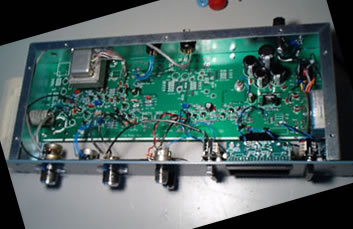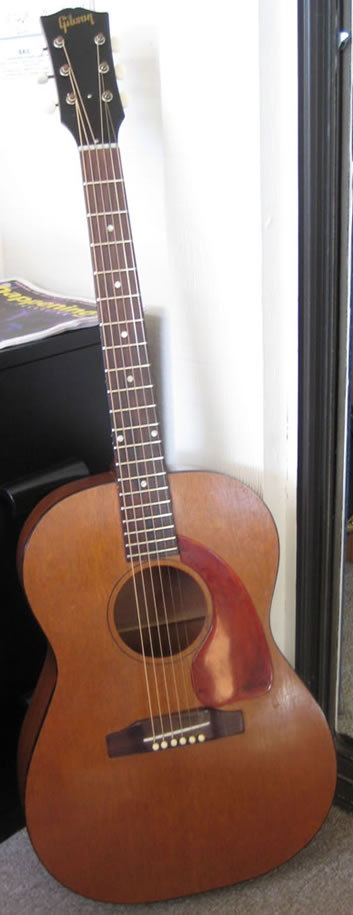MC76 Photos:

Front | Inside Top | Inside Front Panel | Rack
Audio:
MP3 Rhythm Tracks | MP3 Clips
MC76 Kit Notes:
Great kit from Andrew and the crew at Purple Audio. Based on the original UREI 1176 with enhancements, it's very easy to put together and there's an excellent parts list.
I sourced an original 600 ohm attenuator and input transformer, but Purple supplies a repro attenuator and there are a variety of input transformers (including Neve) that can be utilized.
Visit http://www.purpleaudio.com/ for more info.
MP3: Quick Test of '63 Gibson LG-0 Acoustic Guitar
February 2009
Many times I've written a figure on acoustic and upon recording it became greatly disappointed by how badly it transposed to the recorded medium due primarily to the guitar's low frequency response; it can really make the difference between a performance sounding fantastic (really up-front and clear) and one of demo-ish, speaker-rattling embarrassment.
Signal chain: AKG 414/TLII, Redd 47 preamp, 1176 (Purple MC76 Kit), Pultec EQP EQ Clone.
I like this old guitar a lot as it's fun to play and sounds really nice. Strums great with little tone changes no matter where the pick crosses the strings (usually strumming near the bridge brightens things up and enhances pick attack - but this guitar sounds clear as a bell everywhere) but the best thing about it is it's bottom-end roll-off - which I knew would make it record well the moment I played it in the music store. Sounds almost like it's setup with Nashville tuning, or otherwise very light strings. (Here it's strung with Martin SP4100 phosphor bronze strings, 012-054, and they're a couple of months old.)
Anyway, a lot of what I played here would have completely blown out my cheap PC desktop speakers (they're good low frequency reference monitors) had I tried this with my other acoustics. My '96 Taylor 514 (sold) was a good fingerstyle guitar but couldn't handle strumming very well at all, and like my '07 Martin OM-28MQ was pretty boomy around 200hz. This low-end predominance makes equalization a real chore when recording as I find myself moving the microphone around a lot and rolling off quite a bit of lows on both the microphone and Pultec (I never use VST EQ unless it's absolutely necessary - in other words, to clean something up). In any event, I still have too much 200hz in the acoustic tracks with the Martin, although that guitar sounds wonderful. To be fair, the room I record in is pretty dead and sounds terrible with acoustic guitars live; so, I imagine some of the trouble is attributable to this cause.
Test features Pultec in and out and compressor ratio changes. (As my DIY gear has no indicators on the panels, I refer to some controls as "knobs" and "buttons" while mentioning the settings. Sorry.) I usually (by necessity) employ the Pultec with acoustics like an effect - mostly to exaggeratingly boost high-end and cut bottom. With this guitar I prefer to mildly highlight the high-mids and shape the bottom out just a touch (I used low boost and cut simultaneously here).
Pultec settings: low 20hz boost 4 cut 5, high 8k boost 5 sharp. MC76 settings: input 30, output 18, attack and release 4, ratio all-in, 12 and 20). Microphone (AKG TLII, set flat, cardioid pattern) was placed at the 12th fret a few inches away and pointed toward the soundhole. No reverb or other effects.
What I attempted here was to (quickly) capture the natural sound of the instrument without having to resort to significant equalization. As this guitar does not suffer from an abundance of low frequencies (something seemingly built into every new guitar) it was relatively easy to get a good representation of it's sound; commensurately, playback exhibits almost no low end distortion due to peak levels. Therefore, without having to contend with low frequency consequences, I'm confident that in the future I'll be able to get some really great sounds from this guitar with a little experimentation.
In my opinion, with the increased use of pickups in acoustics, the tone of such guitars in modern recordings is bordering on atrocious - although not boomy, more akin in sound to electric guitars recorded through DIs - all string, and loose sounding at that. As such, it appears that players, engineers and producers alike have all forgotten what acoustic guitars can and should sound like. For some examples of great (natural) acoustic tone check out: Fleetwood Mac Never Going Back Again, K.D. Lang Trail Of Broken Hearts, America Never Found The Time, Steven Stills Colorado, Cat Stevens Wild World and Paul McCartney Every Night. For me, the primary challenge is to capture the acoustic guitar without it sounding overly bass heavy - either while strumming or finger-picking - and starting with an instrument that does not have a peak resonance in the low frequencies (if you can find one) is the ideal approach.
Note: I highly recommend the vintage Gibson LG-0 if you can find one that sounds nice - see below - and they're dirt cheap! (These were beginner guitars and don't fare well with collector's opinions - thankfully - due mostly to the ladder bracing.) Personally, if it sounds nice and inspires you, you should buy it - especially if it's only a few hundred bucks - and that's exactly what I did. (Investment wise, it's hard to believe the LG-0 could ever lose any value as they are at rock bottom prices now.) This particular example features a rosewood bridge but a plastic nut and saddle - which goes to show that a good guitar doesn't necessarily need bone and fossilized ivory bits. It also stays in tune with excellent intonation. Structurally, the LG-0 has a great neck shape; really nice (old) mahogany body, top and neck; rosewood fingerboard; and is light as a feather weighing only 3.75 pounds. I would definitely seek out another if this one were somehow lost. |

